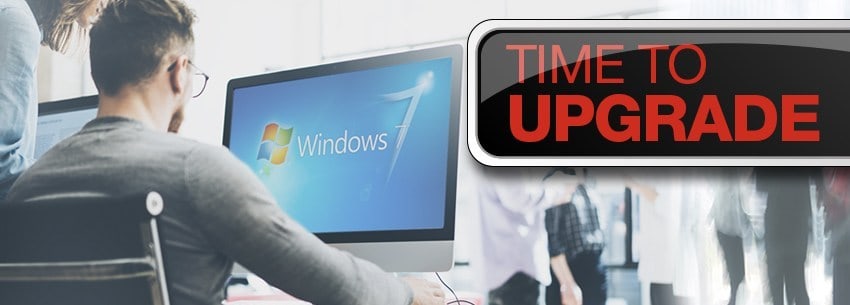WE HAVE A LOT TO SAY
IT SOFTWARE APPS CLOUD NEWS EVENTS
Still Running Windows 7? It’s Time To Upgrade
If you still haven’t upgraded from Windows 7 to Windows 10, you’re not alone, but just because you’re in the company of others, doesn’t mean you should continue pushing off upgrading desktop computers at your business locations. Even though routine maintenance is essential to protecting data from an evolving threat landscape, many businesses aren’t updating software, which has become apparent by the speed at which cyber attacks are spreading from user to user. To reverse this worldwide trend of neglecting software, businesses should look no further than the operating systems running their desktops.
Windows 7 is still popular among desktop users
Globally, more than 38% of desktop computers are still running on Windows 7 — even after the tech giant revealed it would be ending extended support for the OS. Microsoft will no longer provide security updates or support for PCs running Windows 7 after January 14, 2020. Customers will still be able to run Windows 7 after the end of support (EOS) date; however, their PCs will become more vulnerable to security risks, including viruses and malware. To avoid gaps in Windows 7 support, the software giant has been urging its users to “keep the good times rolling by moving to Windows 10.”
What businesses can do
There are a couple of options businesses can take if they’re still running Windows 7 on their PCs. First, businesses can simply upgrade their desktops to Windows 10. For businesses, Windows 10 Pro is recommended. Upgrading to Windows 10 allows businesses to sidestep additional hardware costs — unless their hardware is also out of date. Buying new PCs is another option for businesses. If your PCs are older than three years, Microsoft recommends upgrading your hardware to avoid any potential compatibility issues. Even though support for Windows 7 is officially ending in less than a year, there’s one last option for businesses continuing to ignore the inevitable — if they’re willing to pay for it, of course.
Microsoft’s desktop initiative
Microsoft has its own vision for desktop: It’s called “modern desktop.” “A modern desktop not only offers end users the most productive, most secure computing experience — it also saves IT time and money so you can focus on driving business results,” said Jared Spataro, corporate vice president for Microsoft 365, in a company blog post in September 2018. The tech giant kicked off its initiative by making servicing and support changes to provide “additional deployment flexibility,” according to Sapataro.
What this means is the following: Not all Windows 7 users will need to upgrade to Windows 10 before EOS; customers willing to pay Microsoft additional fees will receive Extended Security Updates (ESU) through January 2023. The tech giant is expected to charge customers as much as $200 per Windows 7 PC after ending its extended support for the operating system on January 14, 2020. While it’s comforting to know Microsoft is willing to work with its Windows 7 customers, especially those unable to upgrade their PCs by early 2020, delaying your upgrade isn’t the best way to go.
The longer you wait to upgrade to Windows 10, the more money your business is going to end up paying in the long run. Upgrade your PCs from Windows 7 to Windows 10 today to ensure they’re protected from today’s ever-evolving security risks.

